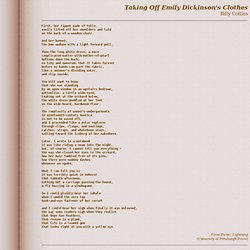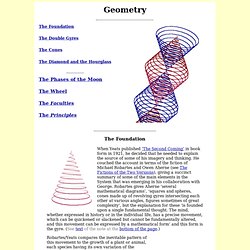

Do not go gentle into that good night. Hope is the thing with feathers. Ozymandias by Percy Bysshe Shelley. The Raven by Edgar Allan Poe. Billy Collins: Taking Off Emily Dickinson's Clothes. Taking Off Emily Dickinson's Clothes Billy Collins First, her tippet made of tulle, easily lifted off her shoulders and laid on the back of a wooden chair.

And her bonnet, the bow undone with a light forward pull. Then the long white dress, a more complicated matter with mother-of-pearl buttons down the back, so tiny and numerous that it takes forever before my hands can part the fabric, like a swimmer's dividing water, and slip inside. You will want to know that she was standing by an open window in an upstairs bedroom, motionless, a little wide-eyed, looking out at the orchard below, the white dress puddled at her feet on the wide-board, hardwood floor.
The complexity of women's undergarments in nineteenth-century America is not to be waved off, and I proceeded like a polar explorer through clips, clasps, and moorings, catches, straps, and whalebone stays, sailing toward the iceberg of her nakedness. --From Picnic, Lightning (University of Pittsburgh Press) Picnic, Lightning by Billy Collins. Billy collins: Sonnet - Billy Collins.
Eliot. Ars Poetica. Hopkins. Frost. The Second Coming - Yeats. William Butler Yeats (1865-1939) Turning and turning in the widening gyre The falcon cannot hear the falconer; Things fall apart; the centre cannot hold; Mere anarchy is loosed upon the world, The blood-dimmed tide is loosed, and everywhere The ceremony of innocence is drowned; The best lack all conviction, while the worst Are full of passionate intensity.

Surely some revelation is at hand; Surely the Second Coming is at hand. The Second Coming! Hardly are those words out When a vast image out of Spiritus Mundi Troubles my sight: a waste of desert sand; A shape with lion body and the head of a man, A gaze blank and pitiless as the sun, Is moving its slow thighs, while all about it Wind shadows of the indignant desert birds. The darkness drops again but now I know That twenty centuries of stony sleep Were vexed to nightmare by a rocking cradle, And what rough beast, its hour come round at last, Slouches towards Bethlehem to be born? Yeats, William Butler. Yeat and the Gyre. The Foundation <a href="/Second.html" target="_blank">‘The Second Coming’</a> in book form in 1921, he decided that he needed to explain the source of some of his imagery and thinking.

He couched the account in terms of the fiction of Michael Robartes and Owen Aherne (see The Fictions of the Two Versions), giving a succinct summary of some of the main elements in the System that was emerging in his collaboration with George. Robartes gives Aherne ‘several mathematical diagrams’, ‘squares and spheres, cones made up of revolving gyres intersecting each other at various angles, figures sometimes of great complexity’, but the explanation for these ‘is founded upon a single fundamental thought. The mind, whether expressed in history or in the individual life, has a precise movement, which can be quickened or slackened but cannot be fundamentally altered, and this movement can be expressed by a mathematical form’ and this form is the gyre.
The Double Gyres. 193. O Captain! My Captain! Whitman, Walt. 1900. Leaves of Grass. Emerson Poem: "Concord Hymn"